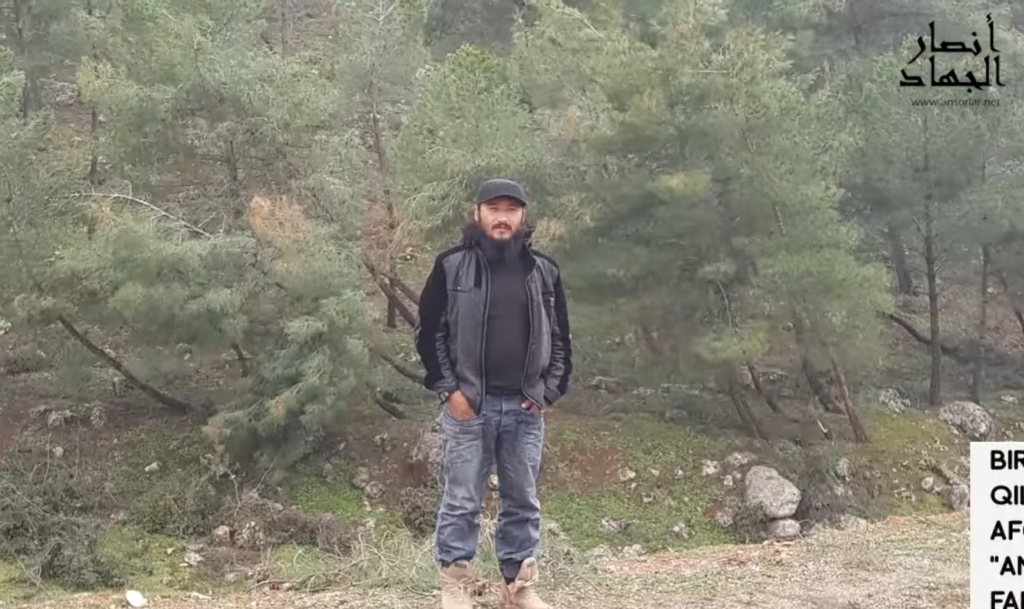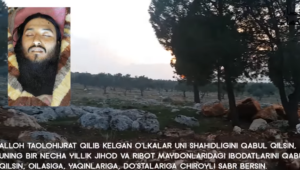
This undated photo reportedly shows Abu Omar al Turkistani in Afghanistan.
Ansar Jihad, an al Qaeda-linked jihadi outfit in Syria that draws most of its members from Central Asia, released a biography of its slain military emir (leader) last month. The emir, known as Abu Omar al Turkistani, was killed in a US drone strike in Idlib Province on Jan. 1.
Turkistani’s jihadi career began in Afghanistan, according to Ansar Jihad’s biography. He reportedly migrated to Afghanistan from China’s Xinjiang region sometime before the US invasion in Oct. 2001. He took part in the Battle at Tora Bora before fleeing to Pakistan. Other Uighur jihadists, some of whom were detained and held at Guantanamo, also fought at Tora Bora.
After fleeing Afghanistan, Turkistani was arrested by Pakistani intelligence and held for approximately a decade. The video biography said that after he was released from custody, he went back to Afghanistan and joined the al Qaeda-linked Islamic Jihad Union (IJU).
The IJU is a splinter of the Islamic Movement of Uzbekistan (IMU) comprised mainly of Uzbeks. Other ethnicities and nationalities are also present within the IJU’s ranks. Ansar Jihad stated that Turkistani was able to speak multiple languages — including Pashto, English, and Russian — and this allowed him to become a commander within the IJU. He retained this position until sometime in 2015, when he migrated to Syria to join the jihad there.
In Syria, he joined Ansar Jihad and became its military leader, taking part in battles in Aleppo and Latakia. While most of Ansar Jihad’s fighters appear to be from Central Asia, it may also contain Turkish fighters as some of its media output (including statements published on Telegram) are in Turkish. However, most of its media is in Uzbek. The organization has highlighted two training camps, including one for snipers, in its propaganda. It has also advertised its role in the fighting in Aleppo, including in the Oct. 2016 al Qaeda-led offensive named the “Battle of Abu Omar Saraqib.”
Turkistani was killed in what Ansar Jihad described as a “bomb attack on his car” on Jan. 1. The jihadist group said the attack happened in northern Hama province, but the Pentagon only described airstrikes occurring near Sarmada, Idlib on that day. The discrepancies in the locations could be due to the jihadist group trying to obscure details, as Turkistani was reportedly killed alongside a longtime al Qaeda veteran known as Abu Khattab al Qahtani.
The details posted online by jihadis indicate that the Abu Omar al Turkistani killed by a drone strike is the same one who was leading Ansar Jihad. For example, jihadis posted the same “martyrdom” photo (seen on the right) for each of them.

When Abu Omar al Turkistani’s death was first announced, he was identified as a senior figure in the Turkistan Islamic Party (TIP), al Qaeda’s ethnic Uighur group, as well as a high-ranking member of Jabhat Fateh al Sham (which was formerly known as Al Nusrah Front). Jabhat Fateh al Sham (JFS) is now part of the “Assembly for the Liberation of Syria,” or Hay’at Tahrir al Sham (HTS). JFS and four other groups merged to form HTS in January. Turkistani reportedly played a leading role in the merger talks and may have been in line to assume a position in the newly formed entity. [See FDD’s Long War Journal report, Pentagon: Airstrikes kill 20 or more al Qaeda fighters in northern Syria.]
As Turkistani was killed with two al Qaeda members, it is likely that Ansar Jihad is a sub-unit of JFS/HTS and that he was a member of al Qaeda. It is unclear what the relationship is between Ansar Jihad and the aforementioned TIP. But it is likely the two coordinate their operations based on the TIP’s close relationship with HTS and the fact that there are Uighurs in both groups.







